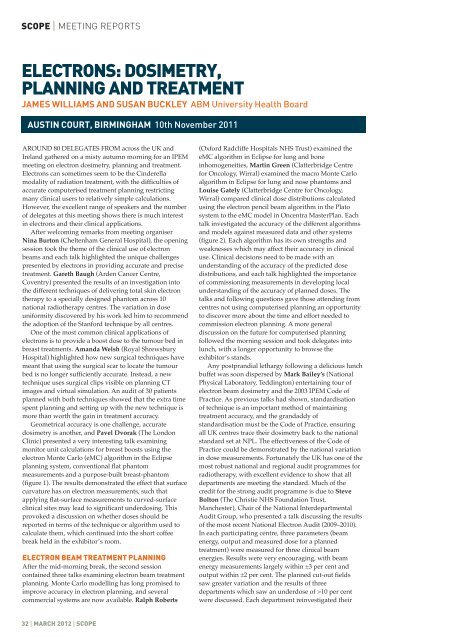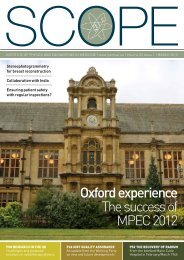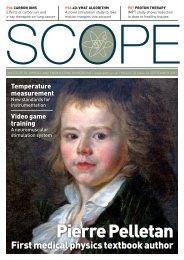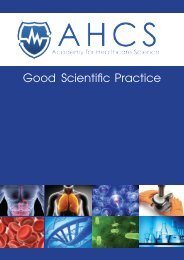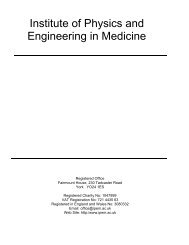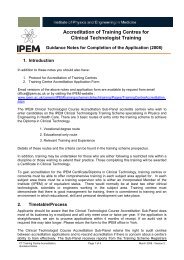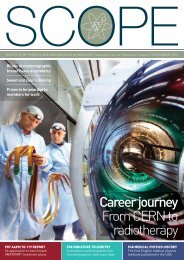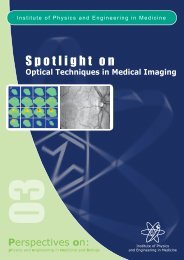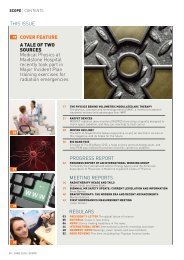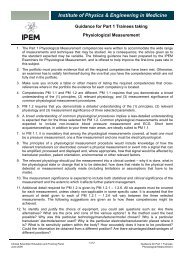March 2012 - Institute of Physics and Engineering in Medicine
March 2012 - Institute of Physics and Engineering in Medicine
March 2012 - Institute of Physics and Engineering in Medicine
You also want an ePaper? Increase the reach of your titles
YUMPU automatically turns print PDFs into web optimized ePapers that Google loves.
SCOPE | MEETING REPORTS<br />
ELECTRONS: DOSIMETRY,<br />
PLANNING AND TREATMENT<br />
JAMES WILLIAMS AND SUSAN BUCKLEY ABM University Health Board<br />
AUSTIN COURT, BIRMINGHAM 10th November 2011<br />
AROUND 80 DELEGATES FROM across the UK <strong>and</strong><br />
Irel<strong>and</strong> gathered on a misty autumn morn<strong>in</strong>g for an IPEM<br />
meet<strong>in</strong>g on electron dosimetry, plann<strong>in</strong>g <strong>and</strong> treatment.<br />
Electrons can sometimes seem to be the C<strong>in</strong>derella<br />
modality <strong>of</strong> radiation treatment, with the difficulties <strong>of</strong><br />
accurate computerised treatment plann<strong>in</strong>g restrict<strong>in</strong>g<br />
many cl<strong>in</strong>ical users to relatively simple calculations.<br />
However, the excellent range <strong>of</strong> speakers <strong>and</strong> the number<br />
<strong>of</strong> delegates at this meet<strong>in</strong>g shows there is much <strong>in</strong>terest<br />
<strong>in</strong> electrons <strong>and</strong> their cl<strong>in</strong>ical applications.<br />
After welcom<strong>in</strong>g remarks from meet<strong>in</strong>g organiser<br />
N<strong>in</strong>a Burton (Cheltenham General Hospital), the open<strong>in</strong>g<br />
session took the theme <strong>of</strong> the cl<strong>in</strong>ical use <strong>of</strong> electron<br />
beams <strong>and</strong> each talk highlighted the unique challenges<br />
presented by electrons <strong>in</strong> provid<strong>in</strong>g accurate <strong>and</strong> precise<br />
treatment. Gareth Baugh (Arden Cancer Centre,<br />
Coventry) presented the results <strong>of</strong> an <strong>in</strong>vestigation <strong>in</strong>to<br />
the different techniques <strong>of</strong> deliver<strong>in</strong>g total sk<strong>in</strong> electron<br />
therapy to a specially designed phantom across 10<br />
national radiotherapy centres. The variation <strong>in</strong> dose<br />
uniformity discovered by his work led him to recommend<br />
the adoption <strong>of</strong> the Stanford technique by all centres.<br />
One <strong>of</strong> the most common cl<strong>in</strong>ical applications <strong>of</strong><br />
electrons is to provide a boost dose to the tumour bed <strong>in</strong><br />
breast treatments. Am<strong>and</strong>a Welsh (Royal Shrewsbury<br />
Hospital) highlighted how new surgical techniques have<br />
meant that us<strong>in</strong>g the surgical scar to locate the tumour<br />
bed is no longer sufficiently accurate. Instead, a new<br />
technique uses surgical clips visible on plann<strong>in</strong>g CT<br />
images <strong>and</strong> virtual simulation. An audit <strong>of</strong> 30 patients<br />
planned with both techniques showed that the extra time<br />
spent plann<strong>in</strong>g <strong>and</strong> sett<strong>in</strong>g up with the new technique is<br />
more than worth the ga<strong>in</strong> <strong>in</strong> treatment accuracy.<br />
Geometrical accuracy is one challenge, accurate<br />
dosimetry is another, <strong>and</strong> Pavel Dvorak (The London<br />
Cl<strong>in</strong>ic) presented a very <strong>in</strong>terest<strong>in</strong>g talk exam<strong>in</strong><strong>in</strong>g<br />
monitor unit calculations for breast boosts us<strong>in</strong>g the<br />
electron Monte Carlo (eMC) algorithm <strong>in</strong> the Eclipse<br />
plann<strong>in</strong>g system, conventional flat phantom<br />
measurements <strong>and</strong> a purpose-built breast-phantom<br />
(figure 1). The results demonstrated the effect that surface<br />
curvature has on electron measurements, such that<br />
apply<strong>in</strong>g flat-surface measurements to curved-surface<br />
cl<strong>in</strong>ical sites may lead to significant underdos<strong>in</strong>g. This<br />
provoked a discussion on whether doses should be<br />
reported <strong>in</strong> terms <strong>of</strong> the technique or algorithm used to<br />
calculate them, which cont<strong>in</strong>ued <strong>in</strong>to the short c<strong>of</strong>fee<br />
break held <strong>in</strong> the exhibitor’s room.<br />
ELECTRON BEAM TREATMENT PLANNING<br />
After the mid-morn<strong>in</strong>g break, the second session<br />
conta<strong>in</strong>ed three talks exam<strong>in</strong><strong>in</strong>g electron beam treatment<br />
plann<strong>in</strong>g. Monte Carlo modell<strong>in</strong>g has long promised to<br />
improve accuracy <strong>in</strong> electron plann<strong>in</strong>g, <strong>and</strong> several<br />
commercial systems are now available. Ralph Roberts<br />
(Oxford Radcliffe Hospitals NHS Trust) exam<strong>in</strong>ed the<br />
eMC algorithm <strong>in</strong> Eclipse for lung <strong>and</strong> bone<br />
<strong>in</strong>homogeneities, Mart<strong>in</strong> Green (Clatterbridge Centre<br />
for Oncology, Wirral) exam<strong>in</strong>ed the macro Monte Carlo<br />
algorithm <strong>in</strong> Eclipse for lung <strong>and</strong> nose phantoms <strong>and</strong><br />
Louise Gately (Clatterbridge Centre for Oncology,<br />
Wirral) compared cl<strong>in</strong>ical dose distributions calculated<br />
us<strong>in</strong>g the electron pencil beam algorithm <strong>in</strong> the Plato<br />
system to the eMC model <strong>in</strong> Oncentra MasterPlan. Each<br />
talk <strong>in</strong>vestigated the accuracy <strong>of</strong> the different algorithms<br />
<strong>and</strong> models aga<strong>in</strong>st measured data <strong>and</strong> other systems<br />
(figure 2). Each algorithm has its own strengths <strong>and</strong><br />
weaknesses which may affect their accuracy <strong>in</strong> cl<strong>in</strong>ical<br />
use. Cl<strong>in</strong>ical decisions need to be made with an<br />
underst<strong>and</strong><strong>in</strong>g <strong>of</strong> the accuracy <strong>of</strong> the predicted dose<br />
distributions, <strong>and</strong> each talk highlighted the importance<br />
<strong>of</strong> commission<strong>in</strong>g measurements <strong>in</strong> develop<strong>in</strong>g local<br />
underst<strong>and</strong><strong>in</strong>g <strong>of</strong> the accuracy <strong>of</strong> planned doses. The<br />
talks <strong>and</strong> follow<strong>in</strong>g questions gave those attend<strong>in</strong>g from<br />
centres not us<strong>in</strong>g computerised plann<strong>in</strong>g an opportunity<br />
to discover more about the time <strong>and</strong> effort needed to<br />
commission electron plann<strong>in</strong>g. A more general<br />
discussion on the future for computerised plann<strong>in</strong>g<br />
followed the morn<strong>in</strong>g session <strong>and</strong> took delegates <strong>in</strong>to<br />
lunch, with a longer opportunity to browse the<br />
exhibitor’s st<strong>and</strong>s.<br />
Any postpr<strong>and</strong>ial lethargy follow<strong>in</strong>g a delicious lunch<br />
buffet was soon dispersed by Mark Bailey’s (National<br />
Physical Laboratory, Tedd<strong>in</strong>gton) enterta<strong>in</strong><strong>in</strong>g tour <strong>of</strong><br />
electron beam dosimetry <strong>and</strong> the 2003 IPEM Code <strong>of</strong><br />
Practice. As previous talks had shown, st<strong>and</strong>ardisation<br />
<strong>of</strong> technique is an important method <strong>of</strong> ma<strong>in</strong>ta<strong>in</strong><strong>in</strong>g<br />
treatment accuracy, <strong>and</strong> the gr<strong>and</strong>addy <strong>of</strong><br />
st<strong>and</strong>ardisation must be the Code <strong>of</strong> Practice, ensur<strong>in</strong>g<br />
all UK centres trace their dosimetry back to the national<br />
st<strong>and</strong>ard set at NPL. The effectiveness <strong>of</strong> the Code <strong>of</strong><br />
Practice could be demonstrated by the national variation<br />
<strong>in</strong> dose measurements. Fortunately the UK has one <strong>of</strong> the<br />
most robust national <strong>and</strong> regional audit programmes for<br />
radiotherapy, with excellent evidence to show that all<br />
departments are meet<strong>in</strong>g the st<strong>and</strong>ard. Much <strong>of</strong> the<br />
credit for the strong audit programme is due to Steve<br />
Bolton (The Christie NHS Foundation Trust,<br />
Manchester), Chair <strong>of</strong> the National Interdepartmental<br />
Audit Group, who presented a talk discuss<strong>in</strong>g the results<br />
<strong>of</strong> the most recent National Electron Audit (2009–2010).<br />
In each participat<strong>in</strong>g centre, three parameters (beam<br />
energy, output <strong>and</strong> measured dose for a planned<br />
treatment) were measured for three cl<strong>in</strong>ical beam<br />
energies. Results were very encourag<strong>in</strong>g, with beam<br />
energy measurements largely with<strong>in</strong> ±3 per cent <strong>and</strong><br />
output with<strong>in</strong> ±2 per cent. The planned cut-out fields<br />
saw greater variation <strong>and</strong> the results <strong>of</strong> three<br />
departments which saw an underdose <strong>of</strong> >10 per cent<br />
were discussed. Each department re<strong>in</strong>vestigated their<br />
32 | MARCH <strong>2012</strong> | SCOPE


